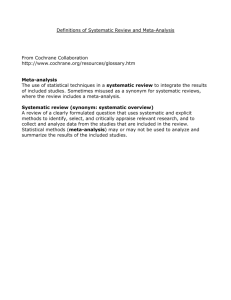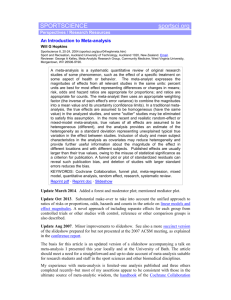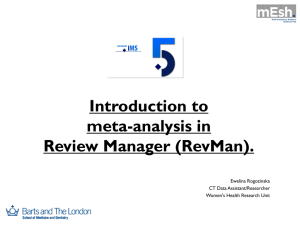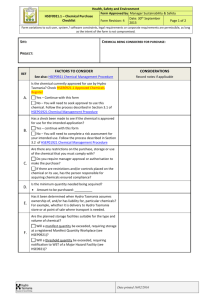Introduction to meta-analysis
advertisement
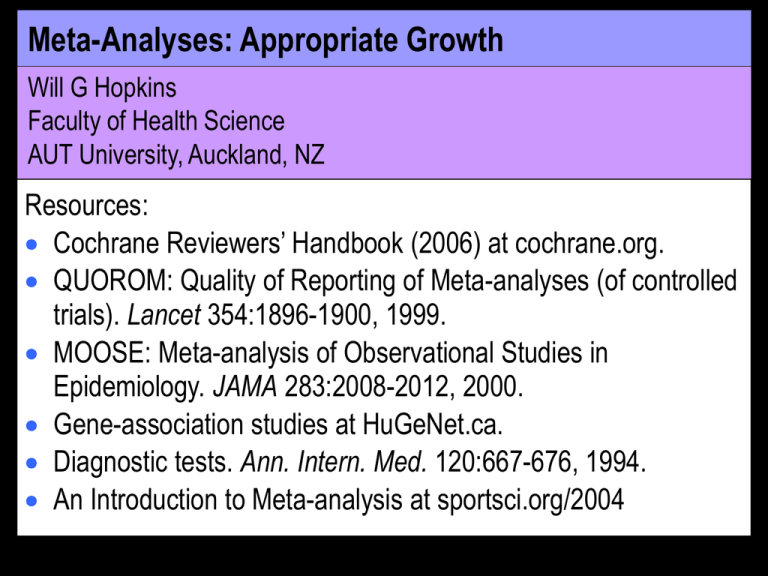
Meta-Analyses: Appropriate Growth Will G Hopkins Faculty of Health Science AUT University, Auckland, NZ Resources: Cochrane Reviewers’ Handbook (2006) at cochrane.org. QUOROM: Quality of Reporting of Meta-analyses (of controlled trials). Lancet 354:1896-1900, 1999. MOOSE: Meta-analysis of Observational Studies in Epidemiology. JAMA 283:2008-2012, 2000. Gene-association studies at HuGeNet.ca. Diagnostic tests. Ann. Intern. Med. 120:667-676, 1994. An Introduction to Meta-analysis at sportsci.org/2004 Overview A meta-analyzed estimate of an effect is: an average of qualifying study-estimates of the effect, with… …more weight for study-estimates with better precision, …adjustment for and estimation of effects of study characteristics, …accounting for any clustering of study-estimates, …accounting for residual differences in study-estimates. Possible problems with the Cochrane Handbook and the Review Manager software (RevMan). An average of qualifying study-estimates of the effect Studies that qualify Spell out selection criteria: design, population, treatment. Include conference abstracts to reduce publication bias due to journals rejecting non-significant studies. Averaging requires estimates of effects in the same units: This: rather than this: Averaging effects derived from continuous variables Aim for dimensionless units, such as change in % or % change. Convert % changes in physiological and performance measures to factor changes then log transform before meta-analysis. • Important when effects are greater than ±10%. • 37% 1.37 log(1.37) • -60% 0.40 log(0.40) meta-analysis 100(eanswer-1)% • 140% 2.40 log(2.40) Physical performance is best analyzed as % change in mean power output, not % change in time, because… a 1% change in endurance power output produces… • 1% in running time-trial speed or time; • 0.4% in road-cycling time-trial time; • 0.3% in rowing-ergometer time-trial time; • 15% in time to exhaustion in a sub-VO2maximal constant-power test; • T/0.50% in time to exhaustion in a supra-VO2maximal constantpower test lasting T minutes; • 1% change in peak power in an incremental test, but… • >1% change in time to exhaustion in the test (but can usually recalculate to % change in power); • >1% change in power in any test following a pre-load (but sometimes can’t convert to % change in power in time trial). Standardizing or Cohenizing of changes is a widespread but misused approach to turn effects into dimensionless units… • To standardize, express the difference or change in the mean as a fraction of the between-subject SD (mean/SD). Standardized change = 3.0 • But study samples are often drawn from populations with different SDs, post so differences in effect size will be very large pre due partly to the differences in SDs. • Such differences are irrelevant and tend to mask interesting differences. • So meta-analyze a measure reflecting strength the biological effect, such as % change. • Combine the pre-test SDs from the studies selectively and appropriately, to get one or more population SDs. • Express the meta-analyzed effect as a standardized effect using this/these SDs. • Use Hopkins’ modified Cohen scale to interpret the magnitude: <0.2 trivial 0.2-0.6 0.6-1.2 1.2-2.0 2.0-4.0 >4.0 small moderate large very large awesome Averaging effects from psychometric inventories Recalculate effects after rescaling all measures to 0-100. Standardize after meta-analysis, not before. Averaging effects from counts (of injury, illness, death) Best effect for such time-dependent events is the hazard ratio. • Hazard = instantaneous risk = proportion per small unit of time. • Proportional-hazards (Cox) regression is based on assumption that this ratio is independent of follow-up time. • Risk and odds ratios change with follow-up time, so convert any to hazard ratios. • Odds ratios from well-designed case-control studies are already hazard ratios. • If the condition is uncommon (odds or risks are <10% in both groups), risk and odds ratios can be treated as hazard ratios. More weight for study-estimates with better precision Usual weighting factor is 1/(standard error)2. Equivalent to sample size, other things (errors of measurement) being equal. Calculate from... the confidence interval or limits the test statistic (t, 2, F) • But F ratios with numerator degrees of freedom >1 can’t be used. the p value • If "p<0.05"…, analyze as p=0.05. • If "p>0.05“, can’t use. To get standard error for controlled trials, can also use… SDs of change scores, post-test SDs (but very often gives large standard error), P values for each group, but not if one is p>0.05. DO NOT COMPARE STATISTICAL SIGNIFICANCE IN EXPERIMENTAL AND CONTROL GROUPS. If none of the above are available for up to ~20% of studyestimates, assume a standard error of measurement to derive a standard error. If can’t get standard error for >20% of study-estimates, use sample size as the weighting factor. • The factor is (study sample size)/(mean study sample size). • Equivalent to assuming dependent variable has same error of measurement in all studies. • For groups of unequal size n1 n2, use n = 4n1n2/(n1+n2). • Divide each study’s factor by the number of estimates it provided, to ensure equal contribution of all studies. Adjustment for effects of study characteristics Include as covariates in a meta-regression to try to account for differences in the effect between studies. Examples: duration or dose of treatment; method of measurement of dependent variable; a score for study quality; gender and mean characteristics of subjects (age, status…). • Treat separate outcomes for females and males from the same study as if they came from separate studies. • If gender effects aren’t shown separately in one or more studies, analyze gender as a proportion of one gender: e.g., for a study of 3 males and 7 females, “maleness” = 0.3. Number of available study-estimates usually limits the analysis to main effects (i.e., no interactions). Use a correlation matrix to identify collinearity problems. Accounting for any clustering of study-estimates Frequent clusters are several post tests in a controlled trial or different doses of a treatment in a crossover. Treating each post test or dose as a separate study biases precision of the time or dose effect low and precision of all other effects high. Fix with a mixed-model (= random-effect) meta-analysis. Mixed modeling would also allow inclusion of effects in control and experimental groups as a cluster. Current approach is to include only their difference… …which doesn’t allow estimation of how much of the metaanalyzed effect is due to changes in the control groups. Accounting for residual differences in study-estimates There are always real differences in the effect between studies, even after adjustment for study characteristics. Use random-effect meta-analysis to estimate the real differences as a standard deviation. The mean effect ± this SD is what folks can expect typically from setting to setting. • For treatments, the effect on any specific individual will be more uncertain because of individual responses and measurement error. Other random effects can account for any clustering. A simple meta-analysis using sample size as the weighting factor is a random-effect meta-analysis. Possible problems with Cochrane and RevMan Comparison of subgroups and estimation of covariates “Subgroup analyses can generate misleading recommendations about directions for future research that, if followed, would waste scarce resources.” “No formal method is currently implemented in RevMan. When there are only two subgroups the overlap of the confidence intervals of the summary estimates in the two groups can be considered…” Random-effects modeling “In practice, the difference [between RevMan and more sophisticated random-effects modeling] is likely to be small unless there are few studies.” Really? Forest and funnel plots Some minor issues and suggestions for improvement. This presentation will be available from: Wait for Sportscience 11, 2007, or contact will@clear.net.nz


